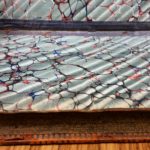
Check out our Instagram page, where we will be posting pictures of interesting finds in our collection and new acquisitions!
You can find us at https://www.instagram.com/nymasoniclibrary/
If using the app on your phone, find us at @nymasoniclibrary

Check out our Instagram page, where we will be posting pictures of interesting finds in our collection and new acquisitions!
You can find us at https://www.instagram.com/nymasoniclibrary/
If using the app on your phone, find us at @nymasoniclibrary
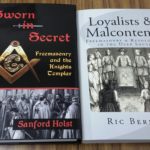
If you are interested in history and its relation to Freemasonry, come visit the library, and check out our recent acquisitions to the book collection!
Sworn in Secret: Freemasonry and the Knights Templar by Sanford Holst
In this book, Sanford Holst’s research details the roots of Freemasonry, when it was still operating as a secret society before 1717, and its development during this time period. Also, the book explores Freemasonry’s relations with the Knights Templar and the Vatican. Holst was able to gain access to many related documents that are not generally accessible to the public and most Masons. Thus, his research has culminated into an important text that provides new information and perspectives on Freemasonry’s history.
Loyalists and Malcontents: Freemasonry & Revolution in the Deep South by Ric Berman
Author of The Foundations of Modern Freemasonry and Schism, Ric Berman provides another important text regarding the relations between Freemasonry and the United States. Berman traces the history of freemasonry in South Carolina and Georgia to its beginnings in the colonial era, into the end of the 18th century. As such, this text covers how the culture of the South and the American Revolutionary War would impact the development of freemasonry in this part of the United States.
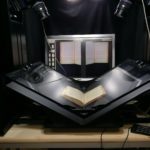
By Joseph Patzner
Over time, the materials that make up books will naturally breakdown, with the potential of accelerated degradation, due to non-ideal conditions leading to materials to be at risk of damage with regular use. Since much of the information in our collection is of value and significance to independent researchers, Lodges, and Masons, it is important that the content contained in these documents remain accessible beyond the lifetime of the physical document were it to become damaged or destroyed. To support preservation and access to information from collection materials, the Chancellor Robert R Livingston Masonic Library is currently digitizing select bound material, like Grand Chapter Proceedings, and unbound documents from the collection including Lodge Historical Files. Moreover, by creating digital facsimiles, we help to expand access to the collection.
Though it would be great to have digital copies for each book in the collection, it is not sensible to attempt to digitize “everything,” as there may not be a demand for access to certain books or copyright restriction may limit the number of electronic copies that can be created for distribution.
Current Digitization Projects:
Grand Chapter of New York Proceeding Volumes
Free and Accepted Mason Reading Course Books
Lodge Historical Files, including Lodge notices and ephemera from Lodge events
In addition to digitizing items currently in the collection, the Library also offers researchers and Masons the opportunity to have items from their Lodge or personal collection digitized.
As we continue to digitize materials, learning how and which materials patrons are using will help us gain an understanding into how we can adapt our digitization program to support the needs of current patrons, while also expanding our reach to Masons and researchers who may be unable to visit the Library but are interested in working with the collection.
For more information about digitization services, click here.
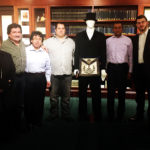
The Library’s First Reading Discussion Meeting of 2017 was held here on January 17th, 2017, to discuss The White Leather Apron, a paper by the late RW Spiridon Arkouzis.
The meeting was a success, with discussion held amongst a small but dedicated group of Brothers from the Tenth Manhattan District. The event was coordinated by Worshipful Michael Matsas, Master, Abravanel Lodge No. 1116.
The Chancellor Robert R Livingston Masonic Library of the Grand Lodge of New York will now be holding Reading Discussion Meetings on the Second Tuesday of each month!
Please check back to see the topic for the next Discussion Topic, to be held on February 14th, 2017!

The Livingston Masonic Library’s Free 2017 Lecture Series: Lecture No. 1
RW Pierre de Ravel d’Esclapon will present a lecture titled:
“Solomon’s Temple: Separating Fact from Fiction”
Join us at 6:30 p.m. on January 26 for the first lecture of 2017 in the Library’s Monthly Series, which is open to all, Mason and non-Masons alike.
This month, RW Pierre de Ravel d’Esclapon will be lecturing on Solomon’s Temple: Separating Fact from Fiction. Having delivered lectures to Masons and non-Masons, we are honored to have this recognized historian deliver what promises to be a fascinating lecture here at the Library.
This Lecture is a companion lecture to the Library’s December 2016 Magic Lantern Slide show, which focused on the 1926 understanding of the Evolution and Restoration of King Solomon’s Temple. We are excited to learn of the changes in knowledge about this important building which features so prominently in Masonic symbolism.
This lecture is graciously sponsored by France-La Clémente-Amitié-Comopolite Lodge No. 410 of the Tenth Manhattan District. All of the Library’s lectures are posted on our YouTube Channel.
RW Pierre de Ravel d’Esclapon is the First Vice President of the Chancellor Robert R Livingston Masonic Library. A graduate of the Harvard Law School, he is now a Professor of Law at the University of Montréal Law School, and by avocation, a historian. RW d’Esclapon has written extensively on historical topics, and has lectured several times as part of the Distinguished Speakers Series at the New-York Historical Society, at the John Jay Homestead, the National Arts Club, the Holland Lodge Historical Society and, most recently, as one of the keynote speakers for the Bicentennial of the Grand Encampment of Knights Templar, held in New York in July of 2016.
We are thrilled to welcome him as a speaker in the Library!
Please RSVP at info@nymasoniclibrary.org. White wine will be served.
Please note: Photo ID is required to enter the Grand Lodge of New York.
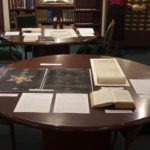
Periodically, the Chancellor Robert R Livingston Masonic Library of the Grand Lodge of New York receives requests from a Lodge Master to visit the Library as one of their Lodge Meeting events. Either I stay late to welcome them into the Library, or one of our Library Trustees from the NYC area comes in that evening to do so.
As the Curator of the Museum’s Artifact Collection, when I know a Lodge is coming to visit, and I have enough advance notice, I try to find artifacts related to the Lodge as well as information about the Lodge which might be of interest to the Lodge members. I then arrange the material on our tables for the Lodge members’ perusal.
We received such a request from Mount Moriah Lodge No. 20, which meets in the Ionic Room here at Grand Lodge for a December visit. RW Demetrios “Jim” Melis, Library Trustee, gave a short talk in the Lodge about the Library, and then brought the Lodge members to the Library to show them our exhibits and the material I had prepared for them.
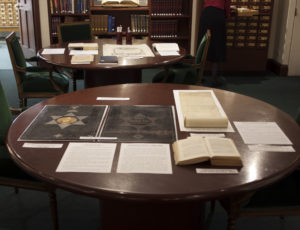
Moriah Lodge No. 20 was warranted as Mount Moriah No. 132 in 1806, and became No. 27 in 1839. In 1973, it merged with Pioneer Lodge No. 20 to become Mount Moriah Lodge No. 20. One of the early members of Mount Moriah Lodge No. 27 was Grand Tiler Greenfield Pote, who, in 1843, famously gave the first dollar to the newly-proposed fund. This fund was designed for:
1st. The erection of a HALL in the City of New-York, for the Grand Lodge and other Masonic Bodies.
2d. The founding of an ASYLUM for worthy, decayed Masons, their Widows and Orphans.
So, because of the story of RW Pote, for the visit of Mount Moriah Lodge No. 20 to the Library, I arranged on one table materials related to the History of Mount Moriah Lodge No. 20, and on the other table, materials related to the History of Greenfield Pote. These items are listed below:
Table 1: History of Mount Moriah Lodge No. 20
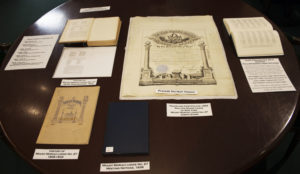
Table 2: History of Greenfield Pote
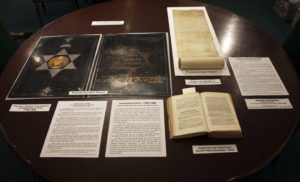
Lodge members were welcome to handle, touch and pick up everything except for the items in bold, and were welcome to take with them the printed-out copies of data.
From all accounts, the Lodge enjoyed the visit to the Library, and were interested and glad to see the special temporary exhibit I designed for them to learn more about the history of their Lodge.
If you belong to a Lodge which would like a similar visit, please don’t hesitate to contact us at info@nymasoniclibrary.org. We are thrilled to share your history with you!
If you belong to a non-Masonic group, and have a particular interest in some aspect of New York history, we may be able to create a similar temporary exhibit focused on your topic for the benefit of your members.
The Book, Archives, Vertical Files and Artifact Collections held by the Chancellor Robert R Livingston Masonic Library of the Grand Lodge of New York contain a wealth of information and memorabilia about New York City, New York State, United States and world history that is unparalleled in its range and breadth.
Come and discover this hidden jewel!
Check out our YouTube channel for videos of our latest lectures!
By Catherine Walter
This Sunday marks Chancellor Robert R Livingston’s 270th birthday. Originally on the Online Museum, to celebrate his birthday we re-publish below details of his life as a patriot and as a Mason.
| Robert R Livingston’s great-grandfather, Robert Livingston, moved from Holland to New York around 1675. In 1686, he purchased an enormous piece of land in upstate New York, (between 120,000 and 150,000 acres), from the local Native American tribes in the area. He had three sons, Philip, Gilbert and Robert, and he granted Robert 13,000 acres of land.
Robert had one child, Robert R. Livingston, who inherited this estate upon his father’s death. This Robert R. Livingston’s oldest child was also named Robert R Livingston, the subject of this biographical sketch. He was sometimes referred to as Jr. in various documents and Lodge minutes created during his lifetime. All of the following information refers to this Robert R Livingston. (It is intentional that there is no period after his middle initial, as this was the way he signed his name.) |
| In 1777, he became the first Chancellor of the State of New York, serving as such until 1801 (1777; 1778; 1779; 1780; 1781; 1782; 1783; 1784; 1785; 1786; 1787; 1788; 1789; 1790; 1791; 1792; 1793; 1794; 1795; 1796; 1797; 1798; 1799; 1800; 1801). As Chancellor, he administered the oath of office to George Washington at Washington’s inauguration as President of the United States.
The Bible used for the inauguration was the altar Bible from St. John’s Lodge No. 1, New York, NY. This Bible is normally on display and can be viewed at Federal Hall, New York City, unless it is traveling for use in a ceremony. During Robert R Livingston’s time as Chancellor, he was also appointed as Secretary of Foreign Affairs for the United States, serving as such from August, 1781 to August, 1783. In 1801, he resigned as Chancellor in order to accept an appointment as Minister Plenipotentiary to France, where he became friends with Napoleon Bonaparte. During his time in Paris, Robert R Livingston negotiated the Louisiana Purchase, finalizing the agreement in 1803, with James Monroe arriving in time to affix his signature to the contract. (de Peyster, 1876) |
| When Robert R Livingston was in France, he met Robert Fulton, and, eventually, the two of them successfully developed the steam-engine for water navigation. Prior to meeting Fulton, Livingston had tried to engineer a steam-engine for water navigation, but could not develop an engine that went faster than three miles an hour. After he and Fulton worked on the problem while living in France, upon return to New York, they built the “Clermont” in 1807, which was able to travel five miles an hour. Robert R Livingston’s accomplishments also included: helping to develop the New York State canal system; settling boundary issues with the other New England states; publishing works on agriculture; experimenting with gypsum fertilizers and introducing Merino sheep to the area, cross-breeding them with the local sheep.In 1810, he hosted a sheep-shearing festival, celebrated to this day, and hailed as the first county fair in the country. (Christian, 1987) In 1801, he was a founder of the American Academy of Fine Arts in New York. Additionally, Past Grand Master Livingston was so skilled an orator that Benjamin Franklin called him the “Cicero of America.” (de Peyster, 1876) |
| There is a commemorative stained glass window honoring Past Grand Master Livingston in the George Washington Masonic National Memorial in Alexandria, Virginia. When told by Congress that each State could choose two citizens to honor with a statue in the Capital in Washington, D.C., New York State representatives chose Robert R Livingston, along with George Clinton. Erected in 1931 by the Masonic Lodges of the Second Columbia-Dutchess District and the State of New York, there is a Memorial plaque honoring Robert R Livingston at his ancestral home, Clermont, (Clermont State Historic Park, Germantown, NY). Initially built in 1730, the mansion on the estate was burned by the British in 1777. The rebuilt building incorporates charred remnants of the earlier building. (Clermont, 1977)Robert R Livingston has also been honored on numerous commemorative postal stamps. |
| In 1983, the Board of Regents, the governing body for education in New York State, granted a charter to the Chancellor Robert R Livingston Masonic Library of the Grand Lodge of Free and Accepted Masons of the State of New York.
Though given a New York State Charter in 1983, the Library has been in existence since 1885. In 1885, the Grand Master “appointed a Sub-Committee for the purpose of collecting – by gift or loan – Masonic and archaeological objects to be deposited in the Masonic Hall for the information of the Craft, as well to excite their zeal and interest as to gratify their commendable curiosity…The intention was and is to place on permanent exhibition antiquities and other objects of interest to the brethren, such as ancient medals and jewels, rare coins, minerals, old diplomas, certificates and documents; scarce books, and antique lodge furniture, valuable through age, association, history, or rarity; which are known to exist in the possession of lodges or individual brethren. Thus scattered they are of little utility, while, if united they would become of great interest and value…It is earnestly requested that your lodge, and any brother possessed of any article suited to the purpose in view, will place the same at the disposal of the Committee, by whom the safety of such objects will be carefully guarded.” (Lawrence, 1886) While the Library is available to Masons as well as to the general public, in order to take any of the circulating books out of the Library, you must be a New York State Mason. There are 17 self-directed reading courses designed give an introduction to the books and that help focus use of the collection. Additional resources in the Library include subject, biography and Lodge folders. |
| While there is no record found that shows when and where he became a Freemason, in 1771, Robert R Livingston was named as Master of Union Lodge during the constitution of Solomon’s Lodge No. 1 in Poughkeepsie, NY.
When Robert R Livingston became Grand Master of the Grand Lodge of the State of New York, “[his]…election and installation actually closed the brief existence of the Provincial Grand Lodge and opened the history of the Grand Lodge of the State of New York…[He] was the third Grand Master under the Atholl Charter. His predecessors were British Subjects.” (Gosnell, 1983) |
| In a letter that he wrote reflecting on what became known as the Louisiana Purchase, he wrote, “I had long foreseen that the possession of the east bank of the Mississippi…would be insufficient…I therefore (though without power)…endeavored to satisfy the people in power here, that…it was proper to give us all the country above the Arkansas…
“In March, I ventured upon what was here considered as a bold and hazardous measure, a direct and forceful address to him [Napoleon] personally on the subject of our claims [French spoliation claims] upon which, having received positive assurance that they should be fully and promptly paid, I began to look forward to this as a means of accomplishing my other object which I was sure he could not…in the case of war…find any other means of discharging it.” (Livingston, 1803) |
| Upon receiving a Past Grand Master’s jewel on December 2, 1801, Robert R Livingston said, “I receive with great sensibility this new mark of the attachment with which the Grand Lodge have, on so many occasions, honored me. I derive, however, no small consolation when parting with them, from finding my place in the Lodge occupied by a brother who has, by a long series of services, been enabled at once to evince his attachment to the Fraternity and his ability to promote their interest. “I shall wear brethren, with pride and pleasure, the jewel with which the Fraternity have honored me, and consider it as a memorial of the pleasing connection that binds us to each other when the duties I owe the public shall have separated me from them. “Receive my thanks, brethren, for your friendly and affectionate wishes, present to the Grand Lodge my ardent prayers for the present and future happiness of its members, and believe that I shall in every situation of life feel myself deeply interested in their prosperity and that of the respectable and useful society over which they so worthily preside.” (Grand Lodge, 1876)Happy Birthday Chancellor Livingston! Check out the Online Museum for more great facts, artifacts and photos about Brother Livingston. |
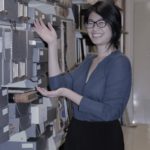
By Jo-Ann Wong
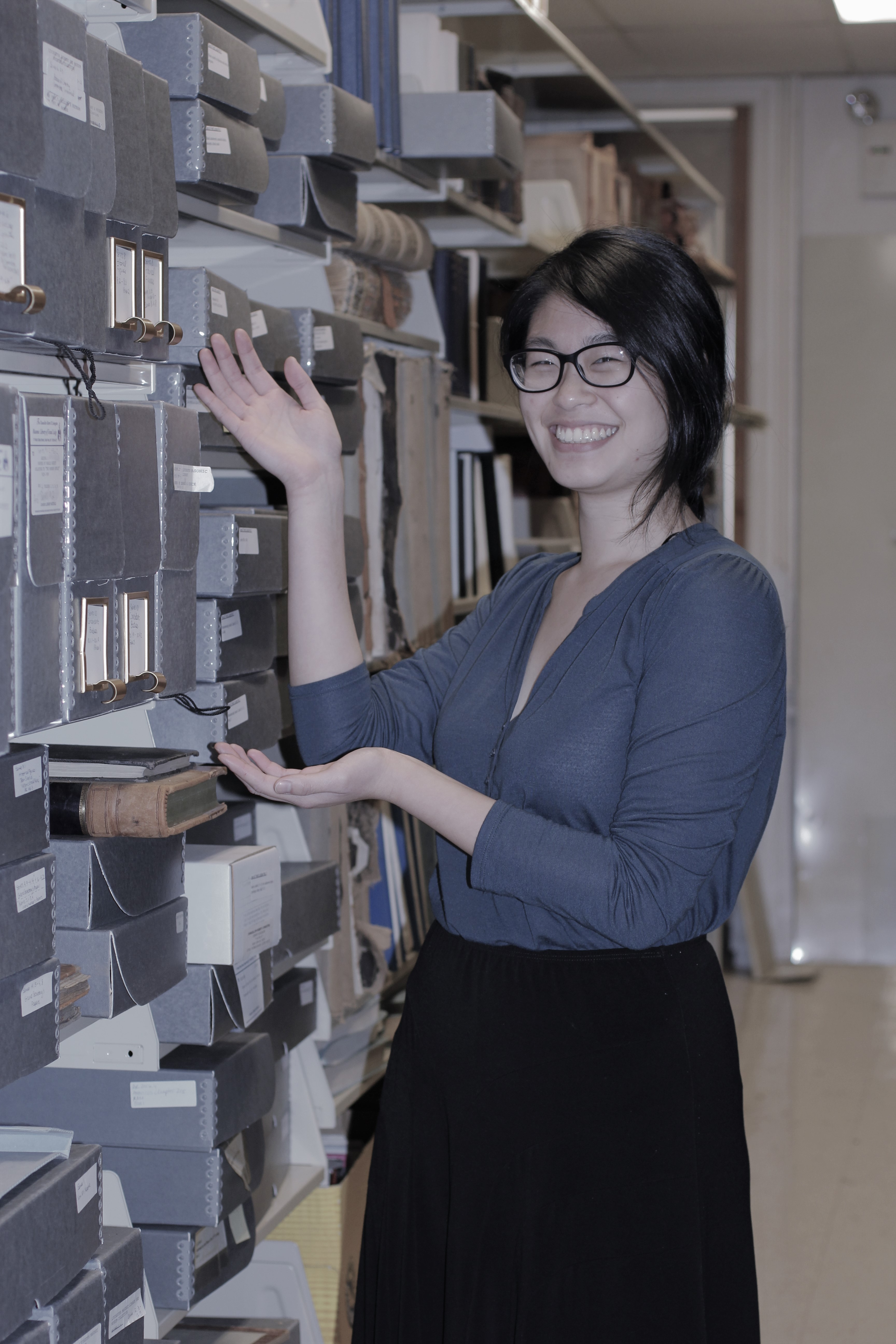 Working as an archives intern at the Chancellor Robert R Livingston Masonic Library has given me an extraordinary amount of insight regarding archival work and the operations of a special collections. Here, I was given the opportunity to work with an archival collection that contained a mass amount of history, dating back to the late 1700s. While going through the manuscripts, I was able to learn more about the history of masonry, as well as aspects regarding the general pervading views of different time periods. For instance, working with papers dating to the Civil War had different concerns and worries than papers found in the era of the 1920s.
Working as an archives intern at the Chancellor Robert R Livingston Masonic Library has given me an extraordinary amount of insight regarding archival work and the operations of a special collections. Here, I was given the opportunity to work with an archival collection that contained a mass amount of history, dating back to the late 1700s. While going through the manuscripts, I was able to learn more about the history of masonry, as well as aspects regarding the general pervading views of different time periods. For instance, working with papers dating to the Civil War had different concerns and worries than papers found in the era of the 1920s.
With this archival collection, my main duties included reorganizing, rehousing, and creating an inventory of the material, as well as updating the finding aid to make the collection more accessible to the public. Throughout this process, I was able to come across interesting materials that were previously hidden in the archives, such as correspondence from both Theodore and Franklin Delano Roosevelt. With the work I have done physically organizing and revising the finding aid, I hope that I have made manuscripts like these more accessible to both the masons and the public.
Overall, learning about this part of American history while exercising my archival skills in a professional setting has been a truly rewarding experience.
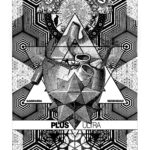 Based on three key elements: art, science and spirituality Armin’s mission is to “awake consciousness” of the miracle and beauty of life from the simplest to the most complex events. He seeks to transmit this combination of thoughts, feelings and knowledge through his artwork which includes: painting, drawing, engraving, urban art, digital design and photography. Armin’s art flows by either combining techniques or applying each one of them separately. Within its abstract nature many of his pieces have a strong spiritual content amalgamated with miscellaneous shapes, colors and architectonic designs. Through his photography, enriched with light, shade and beautiful reflections, Armin invites us to focus our attention to the magnificence of simple daily life images.
Based on three key elements: art, science and spirituality Armin’s mission is to “awake consciousness” of the miracle and beauty of life from the simplest to the most complex events. He seeks to transmit this combination of thoughts, feelings and knowledge through his artwork which includes: painting, drawing, engraving, urban art, digital design and photography. Armin’s art flows by either combining techniques or applying each one of them separately. Within its abstract nature many of his pieces have a strong spiritual content amalgamated with miscellaneous shapes, colors and architectonic designs. Through his photography, enriched with light, shade and beautiful reflections, Armin invites us to focus our attention to the magnificence of simple daily life images.
“Serendipia” represents the way Armin Kuljiš -through lines, strokes and highlights- lets and makes things happen to share his gratefulness for life. It is also an invitation to enjoy art from different perspectives.
About the artist:
Armin Kuljis was born in La Paz, Bolivia in 1981. He graduated as an Architect Summa Cum Laude from Universidad de Aquino in La Paz, Bolivia in 2005. Later, his passion for art and culture brought him to Mexico City where he also earned a Master’s degree in Architecture with an honorable mention at the Universidad Nacional Autónoma de México (UNAM) in 2009. In order to enrich his techniques Armin studied painting, drawing and composition, screen painting art and engraving at the Real Academia San Carlos in Mexico City. In addition, he worked as a professor at both undergraduate and postgraduate levels at the Universidad La Salle in Mexico, DF.
From 2007 to 2015 Armin has participated in several Collective and Individual art exhibits in Bolivia, Mexico and United States. As an artist, his main source of inspiration is nature in all its manifestations; in fact, he devotes an important amount of time studying and teaching architectural biomimechry and sacred geometry.